Title: Awash to Hargeisa
Dates: 26th July to 1st August GPS:
Distance: 594km Total Distance: 20,758km
Roads: All tarmac except for 40km, mountainous before Harar, hilly to Jijiga
Weather: Cool and wet until Jijiga, then warmer on the Somali Plateau
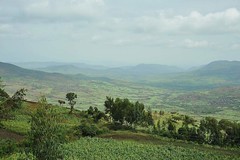 We had heard that there could be difficulties as we
We had heard that there could be difficulties as we
neared the Ethiopia/Somaliland border so Ismael (from Logia) put us in contact with a well-connected guy in Awash, Kome Mahammed whom we looked up on our return from the Afar region. Kome gave us some good advice and arranged for someone (Abdul) to contact in Harar to organise our security to the border.
 The two and a half days ride to the ancient walled city of Harar was always going to be testing. The road crosses the Ahmar Mountains, wriggling its way up and over numerous folds. From Asbe Teferi, I had a tough day, climbing up to 2500m and down, up and down several times. The land is intensively cultivated most of the way and the population is concentrated along the roadside. Once over the first big climb, the problems with the kids returned. It was even worse than before I think; stones, manure, sticks… Then just before lunch, pushing up another huge climb a man with a scythe grabbed on to my bike. Think he must have been high on chewing chat leaves (a very strong stimulant which many men chew for hours every day). I asked him to let go politely, then less politely, then very assertively. This not working I slammed on the brakes so that he fell into my bike. I confronted him and he ran off.
The two and a half days ride to the ancient walled city of Harar was always going to be testing. The road crosses the Ahmar Mountains, wriggling its way up and over numerous folds. From Asbe Teferi, I had a tough day, climbing up to 2500m and down, up and down several times. The land is intensively cultivated most of the way and the population is concentrated along the roadside. Once over the first big climb, the problems with the kids returned. It was even worse than before I think; stones, manure, sticks… Then just before lunch, pushing up another huge climb a man with a scythe grabbed on to my bike. Think he must have been high on chewing chat leaves (a very strong stimulant which many men chew for hours every day). I asked him to let go politely, then less politely, then very assertively. This not working I slammed on the brakes so that he fell into my bike. I confronted him and he ran off.
Needless to say I was pretty stressed by the time John joined me to ride the last couple of kilometres before lunch. After the break I found a small green stick, stripped off the leaves and kept it with me to help ward off anyone who looked like they were going to hang on to my bike. It is against what I would normally do, but I do have the right to defend myself. Holding the stick reduced the problem and I never used it. Thunderstorms built up and ‘exploded’ during the afternoon. I continued cycling through lightning and torrential rain. Eventually I endured the storms too. By the end of the day I had covered 130km in eight and a half hours and was absolutely freezing. John found a building site to camp beside – our last night of camping together. They were building a museum and hotel on an ancient battleground. The locals fought the Italians in 1895, who were trying to take Ethiopia by force, but never succeeded.
I was looking forward to reaching Harar, one of the most important cities on the Muslim map. The city is 1002 years old. Harar developed as an important trading town, owned by its people until Emperor Menelik finally conquered it by force. Harar and Axum in the north were the last two cities to be incorporated into the diverse country Menelik unified (kind of). Abdul arranged for us to stay in a traditional Hararian guesthouse tucked away within the old city walls.
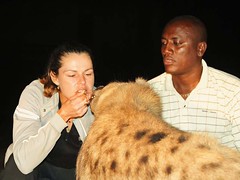 First priority was to see the feeding of the wild hyenas. It is a century-old Muslim tradition unique to Harar which began when the hyenas were fed porridge at a certain stage in the Harar calendar. Over the last fifty years the hyenas have been fed daily, whether there are tourists or not. The hyenas are fed just outside the city walls at the back of the abattoir. A group of about eight showed up to be fed leftovers from the day’s butchery. Once the feeder (who inherited the job about eight years ago from another family member) had started them off he invited people from the small audience to have a go.
First priority was to see the feeding of the wild hyenas. It is a century-old Muslim tradition unique to Harar which began when the hyenas were fed porridge at a certain stage in the Harar calendar. Over the last fifty years the hyenas have been fed daily, whether there are tourists or not. The hyenas are fed just outside the city walls at the back of the abattoir. A group of about eight showed up to be fed leftovers from the day’s butchery. Once the feeder (who inherited the job about eight years ago from another family member) had started them off he invited people from the small audience to have a go.
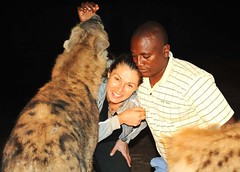 I was one of the first to be offered a go, then John and a few others after that. They are such powerful animals, yet so gentle when they accept meat off a stick held either by hand or by mouth. Zdenek was able to get right in close to film; so close that a young hyena mistook the fluffy microphone for someone offering it a titbit!
I was one of the first to be offered a go, then John and a few others after that. They are such powerful animals, yet so gentle when they accept meat off a stick held either by hand or by mouth. Zdenek was able to get right in close to film; so close that a young hyena mistook the fluffy microphone for someone offering it a titbit!
We took a day off in Harar to absorb the atmosphere and enjoy the town. Abdul took us on a three hour tour. He led us out of the main gate which displayed a sign advertising that Harar had become a UNESCO World Heritage Site in 2006. Abdul said the main benefit of the recognition was that it had encouraged tourism, which in turn had improved the town’s economy. We walked through the Smugglers’ Market in which you can buy materials and various items from all over the world. Harar is not far from the Somaliland border where just about anything and everything is imported.
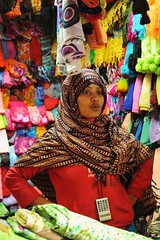 I bought a beautiful piece of Somali material made with traditional dyes. The Smugglers’ Market led to the Recycling Market. Abdul said that anything which is lost in the town ends up in this market. John was like a kid in a lolly shop looking at all the spare parts and tools. Even coffins were available; two were being carried off somewhere. The Recycling Market led into the Christian Market. This was an older section where people can buy spices, grains, vegetables, fruit, chickens and other types of food.
I bought a beautiful piece of Somali material made with traditional dyes. The Smugglers’ Market led to the Recycling Market. Abdul said that anything which is lost in the town ends up in this market. John was like a kid in a lolly shop looking at all the spare parts and tools. Even coffins were available; two were being carried off somewhere. The Recycling Market led into the Christian Market. This was an older section where people can buy spices, grains, vegetables, fruit, chickens and other types of food.
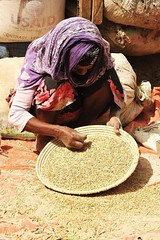 We wandered through many of the 368 alleyways. Originally they were all natural stone and rendering, but now most have been painted up. There are numerous mosques scattered amongst the streets; most are private houses of worship incorporated into the family homes. The small private mosques are used during the week, but people generally attend the main mosque on Fridays.
We wandered through many of the 368 alleyways. Originally they were all natural stone and rendering, but now most have been painted up. There are numerous mosques scattered amongst the streets; most are private houses of worship incorporated into the family homes. The small private mosques are used during the week, but people generally attend the main mosque on Fridays.
Abdul introduced us to Mahammed whom he’d arranged to travel with us for the next two days to the Somaliland border. Mahammed is a Somali, born in Harar with duel Ethiopian/Somaliland citizenship. He seems to be very well connected and it is important to have someone who knows the region with us.
The LandRover has developed a major problem – John pulled a fragment of a gear cog out of the gearbox back in Awash. He kept losing use of some of his gears and the major worry is that there are likely to be more pieces floating in the oil which could become jammed and strip more cogs. Then again, we could be lucky and nothing happen at all. It was a bit like playing Russian roulette and stressful for John especially. He kept draining and checking the gearbox twice a day. Finding LandRover parts, or better still a reconditioned gearbox is difficult in Ethiopia. John had to deliver Zdenek and I to the border (where we were due to meet Omer Jama, who will look after us in Somaliland) and then drive all the way back to Kenya. John was most worried about travelling over the rough road in northern Kenya as he thought this would certainly break up the transmission.
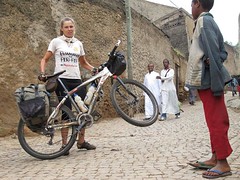 The road to Jijiga from Harar was one of the most picturesque and enjoyable. The first 30km continued with the same kind of problems I’d had before Harar with stone throwers and even more men sitting around chewing chat. After the first decent climb to Babille however, I could draw a line. From that point on the people, including kids were friendly and the hassles ceased. It was an amazing transformation. East of Babille, the scenery was superb.
The road to Jijiga from Harar was one of the most picturesque and enjoyable. The first 30km continued with the same kind of problems I’d had before Harar with stone throwers and even more men sitting around chewing chat. After the first decent climb to Babille however, I could draw a line. From that point on the people, including kids were friendly and the hassles ceased. It was an amazing transformation. East of Babille, the scenery was superb.
 I climbed up a short hill and then descended through a stunning valley speckled with spectacular rock formations on both flanks. Then the land opened out into more vast mountains and green valleys; maize and chat being the main crops cultivated. There were plenty of nomadic livestock herders, camels and a huge troop of baboons beside the road. In the past some of this region was treacherous because of armed conflict. Land mines had been laid and the road blown up.
I climbed up a short hill and then descended through a stunning valley speckled with spectacular rock formations on both flanks. Then the land opened out into more vast mountains and green valleys; maize and chat being the main crops cultivated. There were plenty of nomadic livestock herders, camels and a huge troop of baboons beside the road. In the past some of this region was treacherous because of armed conflict. Land mines had been laid and the road blown up.
 Once over the final long steady climb, the vast Somali plain stretched to the horizon, Jijiga ten kilometres below. During the day, the LandRover had lost 3rd and 4th gear for a couple of hours, but then it returned and behaved as normal. Mahammed took John and Zdenek to meet the best mechanic in Jijiga, but he didn’t have any parts which could help fix the problem. We drove on.
Once over the final long steady climb, the vast Somali plain stretched to the horizon, Jijiga ten kilometres below. During the day, the LandRover had lost 3rd and 4th gear for a couple of hours, but then it returned and behaved as normal. Mahammed took John and Zdenek to meet the best mechanic in Jijiga, but he didn’t have any parts which could help fix the problem. We drove on.
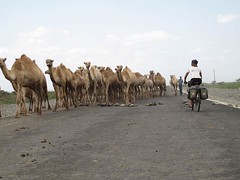 The road to Tog Wajale at the border has just about been completely sealed. The Chinese are about 40km short of completing the job. This made my ride much easier than expected. We had allowed an extra day to reach the border in case of difficulties, but didn’t need it and arrived a day early. I had been coordinating the transfer into Somaliland for about three months with Omer Jama. He has organised visas, the support vehicle, the security car and two security guards and has committed to accompanying Zdenek and me for the ten days we are in Somaliland. Arriving a day early, Omer simply adapted his plans once again and drove out from Hargeisa the next day.
The road to Tog Wajale at the border has just about been completely sealed. The Chinese are about 40km short of completing the job. This made my ride much easier than expected. We had allowed an extra day to reach the border in case of difficulties, but didn’t need it and arrived a day early. I had been coordinating the transfer into Somaliland for about three months with Omer Jama. He has organised visas, the support vehicle, the security car and two security guards and has committed to accompanying Zdenek and me for the ten days we are in Somaliland. Arriving a day early, Omer simply adapted his plans once again and drove out from Hargeisa the next day.
This was the end of the road for John who has to return to the UK for harvest. With the vehicle not behaving as it should, I was pleased that Mahammed was with him at least as far as Harar. Having someone who speaks the language and knows the region is a comfort. It was strange saying goodbye to John. He has done such a brilliant job driving and coordinating the expedition support and I could not have asked for a better person for this expedition. He not only drove safely and maintained the vehicle, he also got involved in the project visits and enjoyed cycling a few kilometres just about every day. We emptied the vehicle and sorted all the gear out at the very average hotel in Tog. John could not drive over the border and Omer was unable to cross into Ethiopia, so they arranged to load all of Zdenek and my belongings on a couple of wheel barrows with a few more valuable items being carried by what was at this stage a little entourage. Immigration was straight forward; getting stamped out of Ethiopia and in to Somaliland. The next and last couple of weeks will be an adventure of a different kind.
I set off at about 2pm towards Hargeisa, one vehicle in front, the other behind. The first 20km was rough, but after that it was all plain cycling. I made it into the Somaliland capital just after 6pm. On the way we made a short stop to see some of the work that Omer’s Taakulo Somaliland Community (NGO) is doing, building a water tank and new latrines at a school. This is a part of their commitment to improving clean water supplies, hygiene and sanitation. They have 24 similar projects on the go, partnering with the Swiss organisation Caritas. Much more about the TSC in the next blog.



{ 4 comments… read them below or add one }
Hi kate I just read about your journey through africa that is really good, if you can please make a video of garowe and hafun and the areas of puntland you will be travelling through that would be so good. Good luck with your ride.
I hope you good luck to finish your destination in Hafuun. It is remarkable and historic journey that had not been done any one before… congratulation . You are heading to Puntland state of somalia , plain ,breezy and spectacular landscapes will exposed to your eyes. please be ready to your camera and full of batteries, please do not forget the city i was born Garoowe. i will check your web site almost every other day til you reach garoowe. I hope you good luck and happy historic journey..
Dear Kate!!!!!,
I hope you to come back from Somalia safely and successfully. As far as I know Cycling in Somalia is very difficult wiith danger both roads and the men. I hope you to be safe and get a very imoortant information about Somalia and all Africa.
Yours Ahmed
Dear Kate
Your health was toasted at the North African feast at RMTC
Looking forward to your return
Cheers
Jonathan